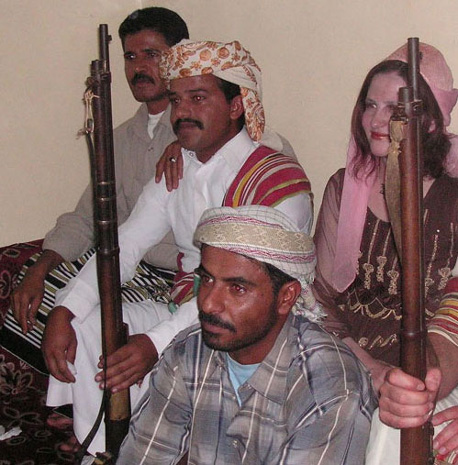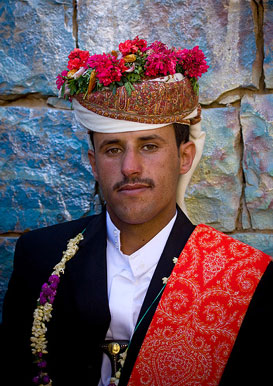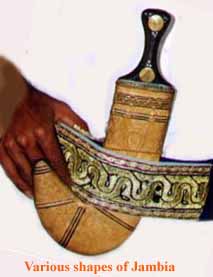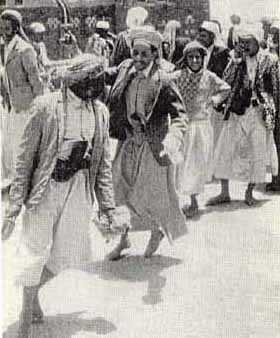
S
AL LAM
S




Left: Traditionally dressed Coorgs' Bridegroom with his Bride * Right: Traditionally dressed Yemeni tribal Bridegroom *
Notice the similarity between the Coorgs' white traditional dress of a Bridegroom and tribal Yemeni white traditional dress of a Bridegroom


Various tribal Yemeni Bridegrooms at the mass wedding ceremony with their traditional dress, and a sword
Yemeni wedding ceremony is performed by their elders without any priests – similar to Coorgs




Ancient Yemenis tribes gather to celebrate their harvest festival and their tribesmen dances with Kharif daggers
Coorgs harvest (puttari) dance Vs Yemeni harvest dance – best evidence ever
 1: Coorgs Puttri Dance Vs
1: Coorgs Puttri Dance Vs
 2: Yemenis Harvest Dance
2: Yemenis Harvest Dance
Study all the photos: Any striking cultural resemblance between Coorgs and ancient Yemenis ?
The known ancient Yemeni tribe, who lives in the region of Yemen and Saudi Arabian border, practices a Male childbirth with a gun salute, which is similar to Coorgs
One explanation of the origin of the Coorgs traces their ancestry to the Yemeni tribral Arabs. This is because of the traditional costume worn by the Coorgs, a long black coat called Kuppia, bears a striking resemblance to the Kuffia worn by ancient Yemeni tribes who lived in the region of Yemeni peninsual In addition, another version credits the Scythian Greek mercenaries, who invaded ancient India in 326 BC with Macedonia Greek Alexander, having founded the race of Coorgs in the region of present day Coorg. Whatever their true origins is, the Coorgs have a distinct ethnic identity, which they have preserved zealously over the centuries. The great cultural factor has been their concept of clan or okka. Each clan had its ancestral home - a huge four-winged structure with imposing doors. Many of these ancestral homes are still in existence though families and land holdings have fragmented.


ANCIENT
YEMENThe history of the Yemen stretches back to Harappan civilization 5,500 years, and its unique culture is still in evidence today in the architecture of its towns and villages. From about 1000 BC this region of the Southern Arabian Peninsula was ruled by three successive civilizations -- Minean, Sabaean and Himyarite. These three kingdoms all depended for their wealth on the spice trade. Aromatics such as myrrh and frankincense were greatly prized in the ancient civilized world and were used as part of various rituals in many cultures, including Egyptian, Greek and Roman. In the 11th century BC, land routes through Arabia were greatly improved by using the camel as a beast of burden, and frankincense was carried from its production center at Qana (now known as Bir 'Ali) to Gaza in Egypt. The camel caravans also carried gold and other precious goods, which arrived in Qana by sea from India. The chief incense traders were the Minaeans, who established their capital at Karna (now known as Sadah), before they were superseded by the Sabaeans in 950 BC. The Sabaean capital was Ma'rib, where a large temple was built. The mighty Sabaean civilization endured for about 14 centuries and was based not only on the spice trade, but also on agriculture. The impressive dam, built at Ma'rib in the 8th century, provided irrigation for farmland and stood for over a millennium. Some Sabaean carved inscriptions from this period are still extant.
The Himyarites established their capital at Dhafar (now just a small village in the Ibb region) and gradually absorbed the Sabaean kingdom. They were culturally inferior to the Sabaeans and traded from the port of al-Muza on the Red Sea. By the first century BC, the Romans had conquered the area. With the rise of the great ancient civilizations in Egypt, Mesopotamia, and along the Mediterranean Sea, ancient Yemen became an important overland trade link between these civilizations and the highly prized luxury goods of South Arabia and points east and south. As a result, several pre-Islamic trading kingdoms grew up astride an incense-trading route that ran northwest between the foothills and the edge of the desert. First, there was the Minaean kingdom, which lasted from about 1200 to 650 BC, and whose prosperity was due mainly to the trade of frankincense and spices. The large and prosperous kingdom of Saba' (Sheba), founded in the 10th century BC and ruled by Bilqis, the queen of Sheba, among others, was known for its efficient farming and extensive irrigation system built around a large dam constructed at Ma'rib. Farther south and east, in the region that would later become South Yemen, were the Qataban and Hadhramaut kingdoms, which also participated in the incense trade. The last of the great pre-Islamic kingdoms was that of Himyar, which lasted from about the 1st century BC until the 525 A.D
One of the greatest, yet most obscure black empires of the ancient world arose in Southern Arabia in what is now called Arabia Felix, or "Happy Arabia". Here on the southern most tip of the peninsula of Yemen, reigned great black dynasties whose roots can be traced to the region in Africa now known as Ethiopia, Arabia's neighbor across the Red Sea. Earliest records show Arabia under the rule of "The Dusky", a name denoting African origin, which reigned with few dynastic interruptions for about 2,500 years. Further evidence of an African-Arabian connection is provided by the Sebaean dynasty, from the Arabian country of Sheba, which colonized Ethiopia in the tenth century B.C. (Ethiopia later conquered Sheba, circa 525 A.D.) The Sabaeans were ruled by a line of queens referred to by the Greeks as Candaces.
Islam spread to Yemen in 639 A.D and 6,000 Syrian Arab Muslims from Mesopotamia invaded western ancient India in 712 A.D
WHO DESTROYED THE ANCIENT YEMEN TRIBES and THEIR CULTURE?
Sana'a - While the furious clashes between the military forces and tribesmen in the governorate of Marib which claimed the lives of hundreds of people and resulted in many injuries and destruction of people's property were approaching an end, other clashes have broke out between Jahm tribe of Khawlan and al-Jadaan tribe of Nahm, two of the most powerful tribes in the governorate. The clashes continue between the two tribes they may worsen the situation and perhaps lead to the outbreak of a war between Khawlan, which is located on a vast region stretching from Sana'a to Mareb and Nahm, who controlled the northern west of the capital Sana'a. But the question was how such tribal conflicts originate? Tribal conflicts are easy to erupt as a result of the binding disputes among tribes over tribal boundaries.
Those disputes were time bombs among the different tribes. The tribal norms and traditions, similar to those in the pre-Islamic period, the underlying reasons for agitating conflicts forcing each member of the tribe to take part in conflicts when hearing the so-called 'Nakaf' (war cries). Nakaf is a call for all the tribes members to be prepared for war when a trespassing or an aggression is perpetrated by another tribe against the land or the pasture areas of the tribe. Tribes in Yemen have a long history of war-dominated heritage as no single tribe in the western region has not entered in armed conflicts with the neighboring tribes.
Moreover, there are persons of the government who were supplying the two warring tribes. It is shameful that tribal conflicts exist in the 20th century while the government takes no action to stop them. Conflicts between tribes are always ended through tribal mediation of neutral tribes; while the established authorities have never taken action so as to end a conflict between two tribes and this is the fault of the state. Conflicts are always a prelude of a disaster and mass killing. One of the biggest outcomes of such conflicts is tribal revenge. Even when the conflict is settled, tribes are not yet ready to forget their men killed.
Hence, they restore to settling the binding scores through assassinating the best men of the rival tribe. Furthermore, they make of the capital city as the appropriate place for settling their scores, the last of which were the clashes between the Bani Dhabian tribes, which took place in Bab Al-Yaman. Tribal conflicts have adversely affected the youths and sons of tribes. Students learning in Sana'a or in the other cities are living a state of unrest and fear of being victims of revenge. Another issue of major concern is why facilities are granted to some parties so as to do away with the educated young people and the political and social activists through tribal feud, for no reason but affiliating or bearing the name of that tribe.





Message to Yemenis - World is Getting Wiser!! – Stop Killing non-Islamic Native Tribes of Yemen

